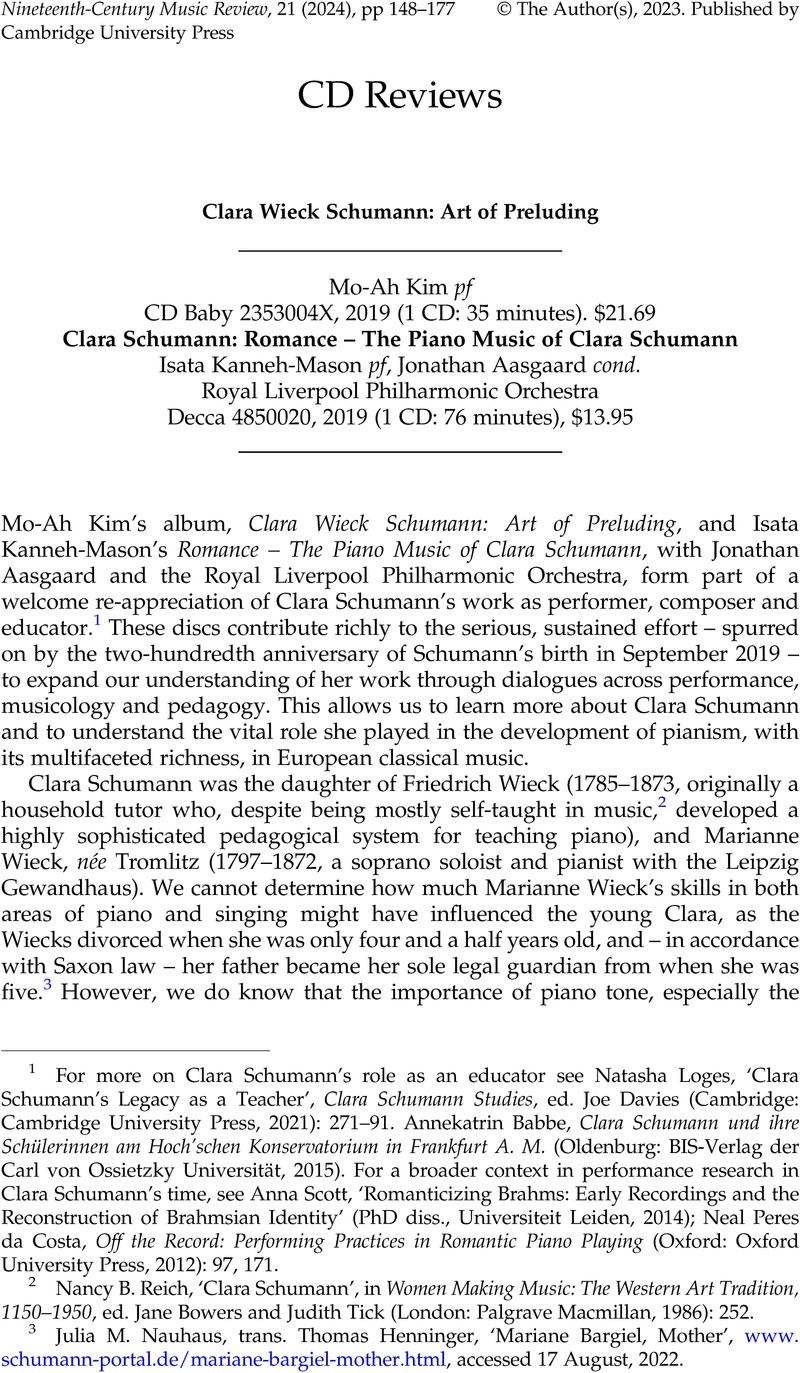Published online by Cambridge University Press: 02 February 2023

1 For more on Clara Schumann's role as an educator see Loges, Natasha, ‘Clara Schumann’s Legacy as a Teacher’, Clara Schumann Studies, ed. Davies, Joe (Cambridge: Cambridge University Press, 2021): 271–91Google Scholar. Babbe, Annekatrin, Clara Schumann und ihre Schülerinnen am Hoch'schen Konservatorium in Frankfurt A. M. (Oldenburg: BIS-Verlag der Carl von Ossietzky Universität, 2015)Google Scholar. For a broader context in performance research in Clara Schumann's time, see Anna Scott, ‘Romanticizing Brahms: Early Recordings and the Reconstruction of Brahmsian Identity’ (PhD diss., Universiteit Leiden, 2014); da Costa, Neal Peres, Off the Record: Performing Practices in Romantic Piano Playing (Oxford: Oxford University Press, 2012): 97, 171Google Scholar.
2 Reich, Nancy B., ‘Clara Schumann’, in Women Making Music: The Western Art Tradition, 1150–1950, ed. Bowers, Jane and Tick, Judith (London: Palgrave Macmillan, 1986): 252Google Scholar.
3 Julia M. Nauhaus, trans. Thomas Henninger, ‘Mariane Bargiel, Mother’, www.schumann-portal.de/mariane-bargiel-mother.html, accessed 17 August, 2022.
4 Stefaniak, Alexander, ‘Clara Schumann's Interiorities and the Cutting Edge of Popular Pianism’, Journal of the American Musicological Society 70/3 (2017): 700CrossRefGoogle Scholar.
5 Wieck., Friedrich Piano and Song / How to Teach, How to Learn, and How to Form a Judgment of Musical Performances (Boston: Lockwood, Brooks, & Company, 1875)Google Scholar.
6 Wieck, Piano and Song, 47.
7 Wieck, Piano and Song, 28.
8 Wieck, Piano and Song, 30.
9 Wieck, Piano and Song, 272.
10 Wieck, Piano and Song, 37. The ability to perform from memory was not commonplace in the early nineteenth century. The emerging trend was spearheaded by Clara Schumann who performed Beethoven’s Piano Sonata No. 23 in F minor, the ‘Appassionata’, Op. 57, from memory in 1837 at the age of 18. See Mishra, Jennifer, ‘A Century of Memorization Pedagogy’, Journal of Historical Research in Music Education 32/1 (2010): 3–18CrossRefGoogle Scholar.
11 Wieck states, ‘With my own daughters I did not teach the treble notes till the end of the first year's instruction, the bass notes several months later’, Wieck, Piano and Song, 27.
12 Reich, Nancy B., Clara Schumann: The Artist and the Woman (Ithaca, NY: Cornell University Press, 2001): 255Google Scholar.
13 Kimber, Marian Wilson, ‘From the Concert Hall to the Salon: The Piano Music of Clara Wieck Schumann and Fanny Mendelssohn Hensel’, in Nineteenth-Century Piano Music, ed. Larry, R. Todd (New York: Routledge, 2004): 316Google Scholar.
14 Reich, Clara Schumann: The Artist and the Woman, 255.
15 Mo-Ah Kim, ‘Towards a Revival of Lost Art: Clara Wieck Schumann's Preluding and Selected 20th-Century Pianist-Composers’ Approaches to Preluding’ (PhD diss., University of Cincinnati, 2019).
16 Kim, ‘Towards a Revival of Lost Art’, 12.
17 Carl Czerny, A Systematic Introduction to Improvisation on the Pianoforte: Opus 200 / Carl Czerny, trans. and ed. by Alice L. Mitchell (New York: Longman, 1983): 5.
18 Friedrich Wieck, Preface to Pianoforte Studies (New York: G. Schirmer, 1901): [2].
19 These include the creation of a pedagogical canon based on a tradition of great Western composers; a system of sorting in which students entering her studio would begin by having lessons with Schumann's daughters for their first year of lessons; a masterclass setting in which students would receive instruction in groups of three; and an emphasis on the need for performers to be truthful to the composer’s meaning. Lara, Adelina De, ‘Clara Schumann's Teaching’, Music & Letters 26/3 (1945); 143–7Google Scholar; Natasha Loges, ‘Clara Schumann’s Legacy as a Teacher’, Clara Schumann Studies, ed. Joe Davies (Cambridge: Cambridge University Press, 2021): 271–91; Stefaniak, Alexander, ‘Clara Schumann and the Imagined Revelation of Musical Works’. Music & Letters 99/2 (2018): 194–223CrossRefGoogle Scholar.
20 Wieck, Piano and Song, and Wieck, Friedrich, Pianoforte Studies (New York: G. Schirmer, 1901)Google Scholar.
21 Robert Schumann, Album for the Young, Op. 68 (Milano: Casa Ricordi, 1919).
22 These include Hanon's The Virtuoso Pianist in 60 Exercises, Hummel's A Complete Theoretical and Practical Course of Instructions on the Art of Playing the Piano Forte, Burgmüller's 25 Études faciles et progressives, Op. 100, to name but a few.
23 See Wollenberg, Susan, ‘Clara Schumann’s “Liebst du um Schönheit” and the Integrity of a Composer’s Vision’, in Women and the Nineteenth-Century Lied, ed. Kenny, Aisling and Wollenberg (Farnham: Ashgate, 2015): 123–39Google Scholar.
24 See Citron, Marcia J., ‘Gender, Professionalism and the Musical Canon’, The Journal of Musicology 8/1 (1990): 102–17CrossRefGoogle Scholar.
25 Clara Wieck Schumann, Piano Works, Domenico Codispoti, Piano Classics PCL10193, 2019.
26 Clara Schumann, Piano Trio and Concerto, Ragna Schirmer. Berlin Classics – 0301325BC, 2019.
27 Until recently, Clara Schumann's music frequently was paired in recordings with that of her husband Robert Schumann or included in compilations of pieces by ‘women composers’.
28 Mo-Ah Kim, ‘Towards a Revival of Lost Art’.
29 Kim, Mo-Ah, ‘Towards a Revival of Lost Art’, referencing Goertzen, ‘By Way of Introduction: Preluding by 18th and Early 19th-Century Pianists’, Journal of Musicology 14/3 (1996): 304, 320Google Scholar.
30 For a far-reaching understanding of the pianistic conventions of the nineteenth century, one can look to the scholarly research carried out by Goertzen, Valerie, ‘Clara Wieck Schumann's Improvisations and Her “Mosaics” of Small Forms’, Beyond Notes : Improvisation in Western Music of the Eighteenth and Nineteenth Centuries, ed. Rasch, Rudolf (Turnhout: Brepols, 2011)Google Scholar; Gooley, Dana, Fantasies of Improvisation: Free Playing in Nineteenth-Century Music (New York: Oxford University Press, 2018)CrossRefGoogle Scholar; and Hamilton, Kenneth, After The Golden Age: Romantic Pianism and Modern Performance (New York: Oxford University Press, 2008)Google Scholar.